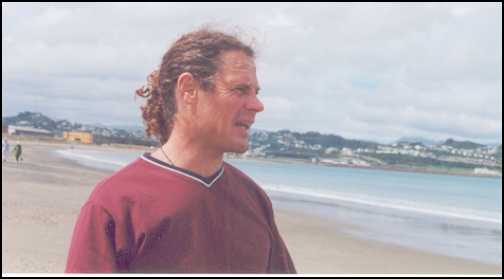Scoop Images: Scientist On Crest Of Wave

Caption: Environmental scientist Shaw Mead at Lyall Bay, Wellington, where an artificial reef could improve surfing conditions and reduce erosion.
From the Foundation for Research, Science and Technology
For immediate release
SCIENTIST ON CREST OF WAVE
Environmental scientist Shaw Mead hopes his waves research will not only reap him a doctorate, but also lead to some better surfing and coastal protection.
Mr Mead, who lives near what he says is some of the best surf in the world - at Whale Bay, Raglan - has used video and computer analysis techniques to research the shape of a breaking wave.
"I've been looking at the tube of the wave and fitting the curves to it to work out the shape," he says. "This is important because it indicates the surfing quality of the wave and how steep the seabed is." Th information can be used to provide surfing breaks that will improve surfing conditions.
Mr Mead is a director of ASR Ltd, a Hamilton-based consultancy specialising in coastal and oceanic environmental work. This includes designing artificial reefs.
Clients include councils, government departments and businesses in New Zealand, Australia, the United Kingdom and India. One of ASR's projects - the Narrowneck coastal protection-surfing reef on Queensland's Gold Coast - won a state environmental award.
Mr Mead's research for his PhD from the University of Waikato was supported by the Technology for Industry Fellowship scheme of the Foundation for Research, Science and Technology.
He says ASR's work is aimed at incorporating artificial reefs into coastal structures. This improves surfing areas, or "breaks", and protects coastal areas from damage caused by wave energy.
"Waves stir up sand and also generate currents that drag sand away," he says. "Dissipating the wave energy offshore by breaking them on a reef reduces the energy that can reach the coast and cause erosion. This results in an increased beach width in the lee of a reef, which acts a buffer zone in a storm."
The reefs are usually made of geotextile bags - "giant sandbags, basically".
Mr Mead was helped in his work by University of Waikato student Aidan Bigham. The research will be useful in designing artificial reefs at Opunake and at Lyall Bay, in Wellington.
-ends-
Contact: * Shaw Mead, Artificial Surfing Reefs Ltd. Ph & fax: (07) 825-0331. Email: s.mead@asrltd.co.nz * Nigel Metge, Technology New Zealand at the Foundation for Research, Science and Technology (Auckland Office), (09) 912-6730, or 021 454-095. Website: www.technz.co.nz
Prepared for the Foundation for Research, Science and Technology by ID Communications. Contact Ian Carson, (04) 477-2525, ian@idcomm.co.nz


 NIWA: Students Representing New Zealand At The ‘Olympics Of Science Fairs’ Forging Pathway For International Recognition
NIWA: Students Representing New Zealand At The ‘Olympics Of Science Fairs’ Forging Pathway For International Recognition Coalition to End Big Dairy: Activists Protest NZ National Dairy Industry Awards Again
Coalition to End Big Dairy: Activists Protest NZ National Dairy Industry Awards Again Infoblox: Dancing With Scammers - The Telegram Tango Investigation
Infoblox: Dancing With Scammers - The Telegram Tango Investigation Consumer NZ: This Mother’s Day, Give The Gift Of Scam Protection And Digital Confidence
Consumer NZ: This Mother’s Day, Give The Gift Of Scam Protection And Digital Confidence NZ Airports Association: Airlines And Airports Back Visa Simplification
NZ Airports Association: Airlines And Airports Back Visa Simplification Netsafe: Statement From Netsafe About Proposed Social Media Ban
Netsafe: Statement From Netsafe About Proposed Social Media Ban